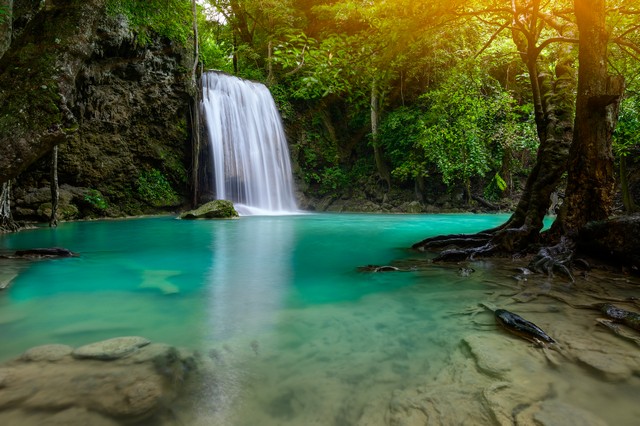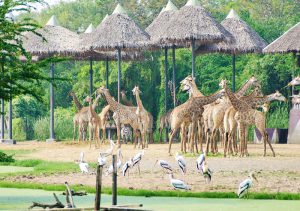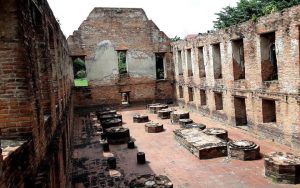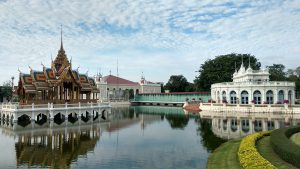Highlight in our tour programs
- Pick up from hotel with private transportation, private tour guide• Visit the well-known attraction of Kanchanaburi, the Bridge on the River Kwai is part of the infamous Death Railway• Full day tour including lunch, private transportation, private tour guide, admission fees
- Visit Allied War Cemetery which is memorial to some 6000 allied prisoners of war (POWs) who perished along the death railway line and were moved post-war to this eternal resting place
- Visit War Museum which provides history of Thailand– Burma Railway and the World War II
- Visit the world-famous Bridge over the River Kwai, a part of Death Railway constructed by Allied POWs
- Board the original Death Railway train for a 30 min journey, passing the death curving bridge, which has built from wooden logs by the prisoners of the World War II aside beauty landscape
- Visit Tham Krasae curving bridge; the famous 335-metre-long wooden which boasts the most beautiful view of the Death Railway and is one of the most difficult obstacles constructions of the railway
- Visit Erawan Waterfall that flowing with emerald green clear waters. It is 7 level, each level can trail up to 6th level, last level is accessible by trekking up few cliffs for those who like a bit more challenge
General Information
Back to World War II in the part of Japanese Forces in Thailand period 1941-1946
During the World War II that conflict all over the world around 30 countries participate in the war. It is divided into 2 battles; Allies Power such as Great Britain, France, USA, Russia, China and Axis Power such as Germany, Italy and Japan, count that they are approximately 100 million soldiers and died as many as 40-50 million people and the war stat in 1939 and end in 1945 about 6 years.
In December 1941 Japan, already at war with China, attacked British, Dutch and American territories in Asia and the Pacific. The first years of the Pacific War brought Japan great success. In 1940 Japan occupied northern Indochina and moves into Southeast Asia into Thailand on Dec 8, 1941, while Thailand had been officially neutral.
The Japanese Forces fought with the British Army in Burma. However, the main target was to invade India. Japan realized that if it used the maritime route to transport the weapons, it would be risky to air attack so it decided to build a railway through Thailand to bring much-needed supplies to Japanese forces in Burma.
The railway was designed to be 258 miles long running through jungles, across rivers, and over the mountain chain that separated Burma and Thailand. The railway was in Thailand 188 miles (304 kilometers) and in Burma 70 miles
(111 kilometers) and has 8 bridges that 7 bridges are in Burma, only 1 bridge in Thailand which has become recognized worldwide as the Bridge on the River Kwai.
It was said it was impossible to build a railway link between Thailand and Burma within a year but The Japanese forces during the second world war did it anyhow.
The Bridge on the River Kwai
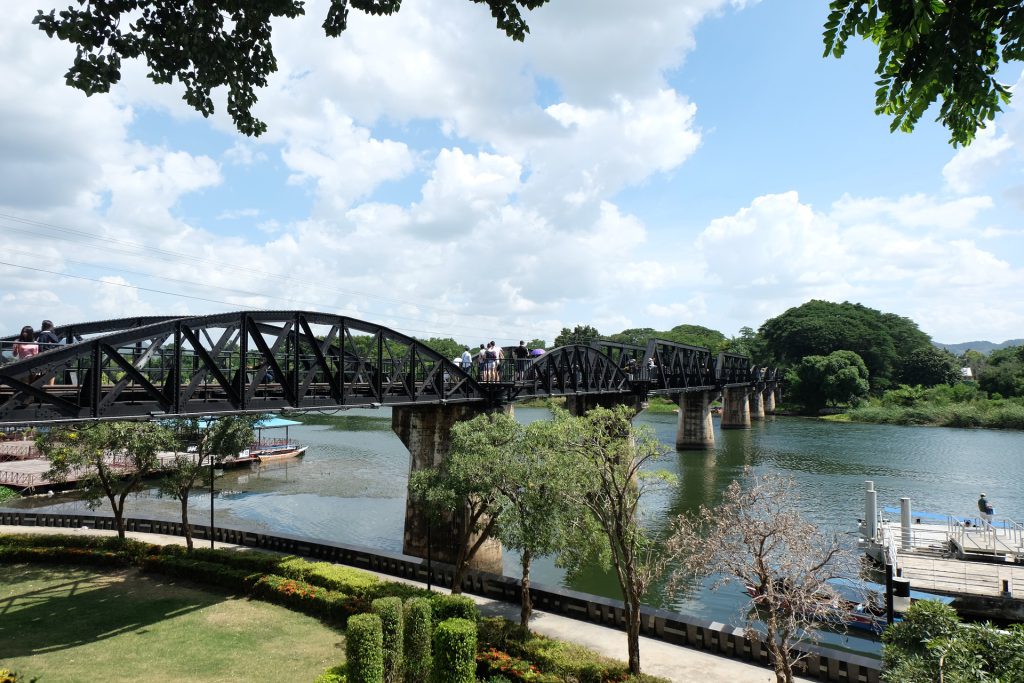
The railway had to be built cross the Kwae Yai River. The Japanese Forces forced about 50,000 British, Australian, American, Dutch and Irish prisoners of war, with more than 275,000 workers to construct the strategic railway crossing through Burma. This construction was full of hardships. The construct was carried out until the step of the bridge over the Kwae Yai River; a temporary wooden bridge, therefore, was built. The construction process was non-stop. The prisoners of war took turns throughout 24 hours a day with the close control of the soldiers. Construction was extremely difficult, with the route crossing through thick, mosquito-infested jungle and uneven terrain while monsoon conditions prevailed.
The Death Railway earned its name from the sheer number of lives lost during its construction, including that of railway bridge number 277 in June 1943, allowing the track to cross what is today known as the Khwae Noi River, and which has become recognized worldwide as the Bridge on the River Kwai. Estimates vary but, of more than 60,000 prisoners of war enslaved on the Death Railway, almost 13,000 are believed to have died, in addition to as many as 90,000 southeast Asian civilian forced laborers.
Since the course of the railway crossed through thick jungle, high mountains and torrential rivers, the work was often very challenging and dangerous. At the same time, much of the work had to be done using bare hands, in the absence of heavy construction machinery. While the construction of the railway included extremely hard physical work, there was also a lack of food, clean water and medicine. In consequence the laborers became very weak, and diseases spread easily in the worker camps.
In addition, the way in which the Japanese and Korean guards treated the laborers was often brutal and ruthless, especially when it seemed that the time schedule could not be met. While all groups suffered enormously under the dreadful living and working conditions the highest death rate was noticed among the Asian forced laborers. Al together 85% of all deaths came from this group.
On the one hand, the Asian laborers often didn’t have the physical condition required for the hard work at the construction sites. They also didn’t have the same discipline, moral and sense of belonging as the POWs who were often captured as complete military units.
On the other hand, the Japanese made a racial distinction between the groups of laborers and treated the Asian workers even worse.
An obvious example for the unequal treatment was the distribution of food among the workers. While the amount of food was inadequate anyway, the Asian laborers received only 600 grams rice per day while the POWs got 660 grams per day.
Almost at the end of the war, the Allies bombed the Bridge. After the war ended in 1945, four kilometers of the railroad from the Burmese-Thai border was demolished by British Army. The remaining 300 kilometers was sold to the State Railway Authority of Thailand in 1947 at a price of 50 million baht or 1,250,000 GBP and now only 130 kilometers is being used.
JEATH War Museum
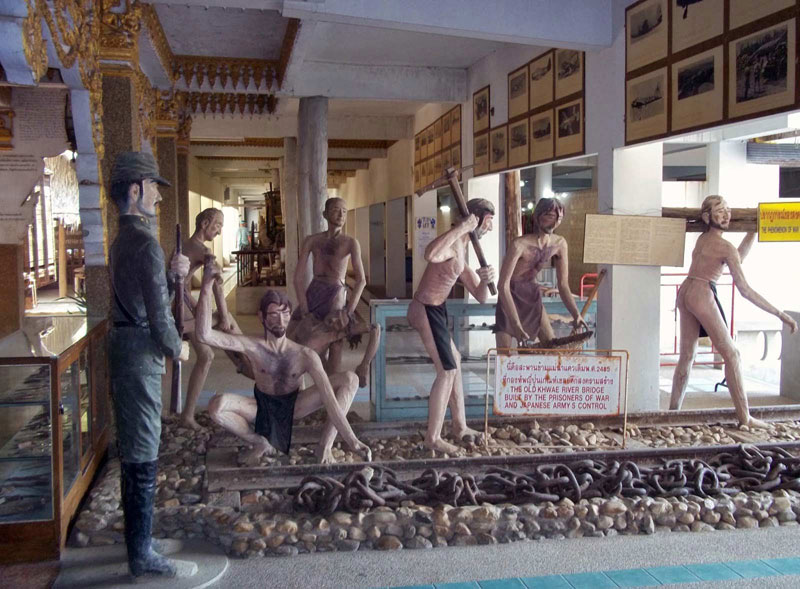
The name JEATH is derived from countries which engaged in the WWII death railway construction from 1942 to 1945, which included Japan, England, America, Australia, Thailand and Holland. Located in the area of Wat Chai Chumphon, the museum is a reconstruction of the POW’s thatched detention hut with cramped, elevated bamboo bunks. On the wall of the huts, photographs and illustrations of the POW’s living conditions are on display. POWs who survived from the camp have donated items to enhance the museum’s atmosphere and authenticity.
Cemeteries
The prisoners-of-war died during the construction of the Death Railway are buried in 2 cemeteries.
– Kanchanaburi (Don Rak) Cemetery is behind the railway station. 6,982 Allied soldiers are buried here. The cemetery covers a very large compound, which is well taken care of and decorated with beautiful plants and trees.
– Khao Poon (Chong Kai) Cemetery was originally the site of one of the main prisoners-of-war camps located on the right bank of Kwai Yai River. It is about 2 kilometers from the town center and can be reached only by boat. This is a small cemetery with 1,750 soldiers buried there.
Tham Kra-Sae Bridge

One of the most difficult obstacles was Tham Kra-Sae Bridge. The construction of the railway in this phase encountered steep mountains adjoining the Kwae Yai River. Japanese engineers needed to build a railway along the river with the 335-meter-long mountains, where about 1,000 prisoners died. It was the longest crossing-abyss bridge of the railway. It was completed in a very short period of time. Prisoners of war worked crazily under the orders of the Japanese prison guards. This was known in the term “speedo” or “keep going”. From April 1943, the construction was carried out very fast because the Japanese Forces wanted it to be completed in August, which was set to a deadline for construction. This period mentioned above was known as Speedo.
The work also covered the famous 335-metre-long wooden Tham Krasae Bridge which boasts the most beautiful view and biggest safety challenge of the Death Railway. The bridge goes parallel with a cliff on one side and overlooks a valley and the Kwai Noi River on the other.
Trains running on the tourist-oriented route must slow down on the bridge for safety because it is supported by its original wooden structure built over 70 years ago.
Half the original wooden sleepers on the bridge were replaced with new wooden sleepers and pieces of the wooden supportive structure were replaced with new wooden parts in order to keep the original wooden aspect of the section.
Erawan Waterfall
What makes Erawan Waterfalls so popular?
Erawan waterfall is another famous waterfall in Kanchanaburi. It is a beautiful waterfall with emerald green clear waters. It is 7 level, each level can trail up to 6th level, last level is accessible by trekking up few cliffs for those who like a bit more challenge. The 7-tiered waterfall looks like the head of Erawan which has 3 heads, it is where the name of the waterfall from. Erawan waterfall is a 7-tiered waterfall every floor has names that are:
The 1st floor is a small waterfall suitable for sitting and take a rest.
The 2nd floor is suitable for people who want to go into the water and play with fish.
The 3rd floor, water on this floor flow from very high tourist can play and go into the water.
The 4th floor is a slide for people who like excitement.
The 5th floor has a wide area suitable for water play.
The 6th floor is surrounded by trees.
The 7th floor is the most beautiful floor. It is green water tourists can swim.
For each floor, there are several fishes but the second floor has the most. In addition, there is a nature trail for 1060 meters takes 30 minutes to walk pass through the forest.
Take your time, hiking up to all seven levels and enjoy swimming in the ponds
Dress suggests for this tour
- Casual outfits suitable for walking
- Swimming cloth and dry cloth for changing
There are a lot of stories to tell, come and discover by yourself with us; Click Thailand… our tour guide will happy to tell…
Plan your tours in Bangkok today, book through https://www.clickthailandtour.com We organized tour in Bangkok with an experience in the tourism industry for a person who would prefer searching different things than normal. By our own experience which has been more than 26 years working with tour guides, tour operations and travel agency business so we know what our clients’ needs are. Our English-speaking guides are licensed by the Tourism Authority of Thailand, they will make your trip more comfortable and enjoyable providing quality services that is helpful for you. We believe that you will appreciable and unforgettable experience trip with us; Click Thailand. Let us work to meet your unique travel needs with worry-free travel.
Reasons to book with us
- Premium private tour service
- Authentic travel experience
- Knowledge and experience guide
- Easy payment terms
- No hidden /extra charge
We guarantee you will be satisfied with our service.
